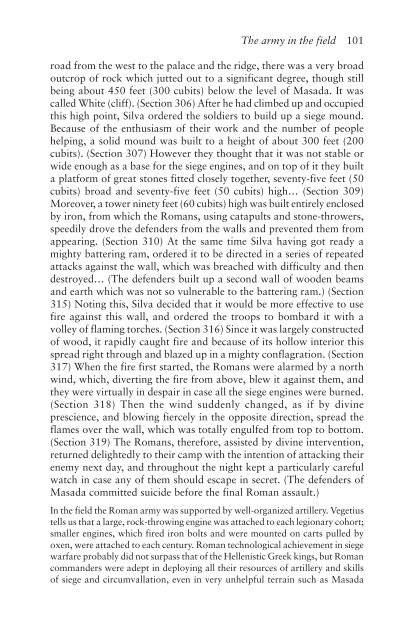The Roman Army, 31 BC–AD 337: A Sourcebook
The Roman Army, 31 BC–AD 337: A Sourcebook
The Roman Army, 31 BC–AD 337: A Sourcebook
You also want an ePaper? Increase the reach of your titles
YUMPU automatically turns print PDFs into web optimized ePapers that Google loves.
<strong>The</strong> army in the field 101<br />
road from the west to the palace and the ridge, there was a very broad<br />
outcrop of rock which jutted out to a significant degree, though still<br />
being about 450 feet (300 cubits) below the level of Masada. It was<br />
called White (cliff). (Section 306) After he had climbed up and occupied<br />
this high point, Silva ordered the soldiers to build up a siege mound.<br />
Because of the enthusiasm of their work and the number of people<br />
helping, a solid mound was built to a height of about 300 feet (200<br />
cubits). (Section 307) However they thought that it was not stable or<br />
wide enough as a base for the siege engines, and on top of it they built<br />
a platform of great stones fitted closely together, seventy-five feet (50<br />
cubits) broad and seventy-five feet (50 cubits) high… (Section 309)<br />
Moreover, a tower ninety feet (60 cubits) high was built entirely enclosed<br />
by iron, from which the <strong>Roman</strong>s, using catapults and stone-throwers,<br />
speedily drove the defenders from the walls and prevented them from<br />
appearing. (Section <strong>31</strong>0) At the same time Silva having got ready a<br />
mighty battering ram, ordered it to be directed in a series of repeated<br />
attacks against the wall, which was breached with difficulty and then<br />
destroyed… (<strong>The</strong> defenders built up a second wall of wooden beams<br />
and earth which was not so vulnerable to the battering ram.) (Section<br />
<strong>31</strong>5) Noting this, Silva decided that it would be more effective to use<br />
fire against this wall, and ordered the troops to bombard it with a<br />
volley of flaming torches. (Section <strong>31</strong>6) Since it was largely constructed<br />
of wood, it rapidly caught fire and because of its hollow interior this<br />
spread right through and blazed up in a mighty conflagration. (Section<br />
<strong>31</strong>7) When the fire first started, the <strong>Roman</strong>s were alarmed by a north<br />
wind, which, diverting the fire from above, blew it against them, and<br />
they were virtually in despair in case all the siege engines were burned.<br />
(Section <strong>31</strong>8) <strong>The</strong>n the wind suddenly changed, as if by divine<br />
prescience, and blowing fiercely in the opposite direction, spread the<br />
flames over the wall, which was totally engulfed from top to bottom.<br />
(Section <strong>31</strong>9) <strong>The</strong> <strong>Roman</strong>s, therefore, assisted by divine intervention,<br />
returned delightedly to their camp with the intention of attacking their<br />
enemy next day, and throughout the night kept a particularly careful<br />
watch in case any of them should escape in secret. (<strong>The</strong> defenders of<br />
Masada committed suicide before the final <strong>Roman</strong> assault.)<br />
In the field the <strong>Roman</strong> army was supported by well-organized artillery. Vegetius<br />
tells us that a large, rock-throwing engine was attached to each legionary cohort;<br />
smaller engines, which fired iron bolts and were mounted on carts pulled by<br />
oxen, were attached to each century. <strong>Roman</strong> technological achievement in siege<br />
warfare probably did not surpass that of the Hellenistic Greek kings, but <strong>Roman</strong><br />
commanders were adept in deploying all their resources of artillery and skills<br />
of siege and circumvallation, even in very unhelpful terrain such as Masada



